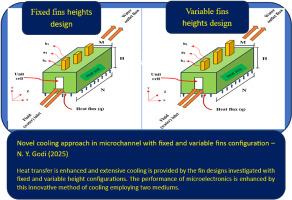Novel cooling approach in microchannel with fixed and variable fins configuration
IF 5
2区 工程技术
Q1 ENGINEERING, MECHANICAL
International Journal of Thermal Sciences
Pub Date : 2025-09-08
DOI:10.1016/j.ijthermalsci.2025.110276
引用次数: 0
Abstract
This paper explores a 3-D numerical simulation of a microchannel with a rectangular configuration. The objective of the study is to enhance performance by minimising thermal resistance within a fixed volume, considering two cases: fixed and variable fin configurations. A heat load of 438 W is applied to the bottom wall surface. Heat dissipation is achieved using forced convection under steady-state laminar conditions, with the fluid Reynolds number ranging from 100 to 150 and the convective air stream Reynolds number between 10 and 12. The fluid and heat fields are predicted using the finite volume (FVM) technique and a computational fluid dynamic (CFD) methodology. The results of the study indicate that minimised resistance decreased in both parallel and counterflow configurations, even with modifications to the fin characteristic profiles. Based on the numerical findings, at a maximum water pumping power of 0.23 W and an average air pressure drop of 0.706 kPa, the counterflow configuration with variable fin designs achieved the best performance, reducing minimised resistance by up to 33.3 %. This is followed closely by the parallel flow design, which achieved a 32.02 % reduction. In the heat sink with a fixed fin design, the fin height-to-length ratio is 1.75. In contrast, for the variable fin design, the fin length ratio ranges from 1.13 to 1.17 in parallel flow, with a height-to-length ratio between 1.29 and 2.23. In the counterflow configuration, the fin length ratio varies from 0.85 to 0.89. The numerical scheme is validated using both experimental and numerical data in open literature.

固定翅片和可变翅片结构微通道的新型冷却方法
本文对矩形微通道进行了三维数值模拟。该研究的目的是通过在固定体积内最小化热阻来提高性能,考虑两种情况:固定和可变翅片配置。底部壁面的热负荷为438w。在稳态层流条件下采用强制对流散热,流体雷诺数在100 ~ 150之间,对流气流雷诺数在10 ~ 12之间。采用有限体积(FVM)技术和计算流体动力学(CFD)方法对流体和热场进行了预测。研究结果表明,在平行和逆流配置中,即使对翅片特征轮廓进行修改,最小阻力也会降低。数值结果表明,在最大抽水功率为0.23 W,平均气压降为0.706 kPa时,采用变翅片设计的逆流配置获得了最佳性能,最大阻力降低了33.3%。其次是平行流设计,降低了32.02%。在固定翅片设计的散热器中,翅片的高长比为1.75。而对于变鳍设计,在平行流中,鳍长比在1.13 ~ 1.17之间,高长比在1.29 ~ 2.23之间。逆流配置时,翅长比在0.85 ~ 0.89之间变化。利用公开文献中的实验和数值数据验证了该数值方案。
本文章由计算机程序翻译,如有差异,请以英文原文为准。
求助全文
约1分钟内获得全文
求助全文
来源期刊

International Journal of Thermal Sciences
工程技术-工程:机械
CiteScore
8.10
自引率
11.10%
发文量
531
审稿时长
55 days
期刊介绍:
The International Journal of Thermal Sciences is a journal devoted to the publication of fundamental studies on the physics of transfer processes in general, with an emphasis on thermal aspects and also applied research on various processes, energy systems and the environment. Articles are published in English and French, and are subject to peer review.
The fundamental subjects considered within the scope of the journal are:
* Heat and relevant mass transfer at all scales (nano, micro and macro) and in all types of material (heterogeneous, composites, biological,...) and fluid flow
* Forced, natural or mixed convection in reactive or non-reactive media
* Single or multi–phase fluid flow with or without phase change
* Near–and far–field radiative heat transfer
* Combined modes of heat transfer in complex systems (for example, plasmas, biological, geological,...)
* Multiscale modelling
The applied research topics include:
* Heat exchangers, heat pipes, cooling processes
* Transport phenomena taking place in industrial processes (chemical, food and agricultural, metallurgical, space and aeronautical, automobile industries)
* Nano–and micro–technology for energy, space, biosystems and devices
* Heat transport analysis in advanced systems
* Impact of energy–related processes on environment, and emerging energy systems
The study of thermophysical properties of materials and fluids, thermal measurement techniques, inverse methods, and the developments of experimental methods are within the scope of the International Journal of Thermal Sciences which also covers the modelling, and numerical methods applied to thermal transfer.
 求助内容:
求助内容: 应助结果提醒方式:
应助结果提醒方式:


